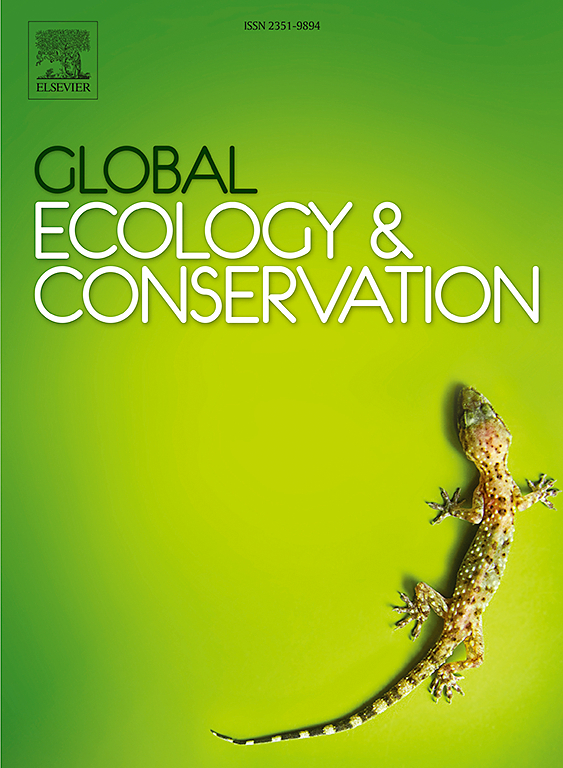Effects of canopy gap size on the recruitment of Shorea robusta Gaertn. F. seedlings in the Terai forests of Nepal
IF 3.5
2区 环境科学与生态学
Q1 BIODIVERSITY CONSERVATION
引用次数: 0
Abstract
Gap dynamics is a crucial ecological process in which canopy openings created by disturbances influence structure, regeneration and growth pattern in forest ecosystems. The canopy gaps (an area > 25 m2 opened by the removal of canopy trees) in the forests are usually caused by both anthropogenic and natural stressors, such as logging, treefalls, windstorms, and fires. Though the canopy gaps play an important role in shaping recruitment of the seedlings and hence the forest ecosystem assemblages, little is known about how the gaps have affected the vegetation establishment in the forest ecosystems, particularly in Terai, Nepal. The present study was carried out in core and buffer zone forests of two lowland national parks of Nepal, viz., Parsa National Park and Bardiya National Park, to assess the influence of gap size on the Shorea robusta seedlings’ recruitment and establishment. Altogether 120 gap sites were sampled ranging in size from 71 to 914.5 m2, which were categorized into small gaps (< 200 m2), medium gaps (200–400 m2), and large gaps (> 400 m2). The mean density of S. robusta seedlings was significantly higher in small (1.98 ind. m−2) compared to the medium-sized (1.37 ind. m−2) and large-sized (0.54 ind. m−2) canopy gaps in both core areas and buffer zones. The small gaps provided the most favorable conditions for seedling recruitment in both locations, possibly due to optimum light and nutrient availability. Moreover, regression analysis showed a significant inverse relationship between seedling density and the size of the canopy gaps. These results indicate that the larger gaps are not favorable for the assemblage and recruitment of S. robusta seedlings, which might be due to the feeble seed dispersal ability of the species for longer distances. Forest managers, therefore, are suggested to maintain small gap sizes to foster the natural regeneration of S. robusta in the forest stands of Terai, Nepal.
林隙大小对柠条增收的影响。F.尼泊尔特赖森林的幼苗
林隙动态是一个重要的生态过程,在这个过程中,干扰产生的林冠开口影响着森林生态系统的结构、更新和生长模式。树冠间隙(一个区域);25( )m2(由于树冠树木的移除而开放)通常是由人为和自然压力因素引起的,如伐木、树木砍伐、风暴和火灾。尽管树冠间隙在形成幼苗的招募和森林生态系统组合方面发挥着重要作用,但对于树冠间隙如何影响森林生态系统中的植被建立,特别是在尼泊尔的Terai,人们知之甚少。本研究以尼泊尔两个低地国家公园Parsa国家公园和Bardiya国家公园的核心林和缓冲林为研究对象,研究了林隙大小对Shorea robusta苗木招募和建立的影响。总共采样了120个间隙点,大小从71到914.5 m2不等,它们被划分为小间隙(<;200 m2),中等间隙(200 - 400 m2),大间隙(>;400 m2)。核心区和缓冲区小林隙(1.98 ind. m−2)和大林隙(0.54 ind. m−2)的柽柳幼苗平均密度显著高于中等林隙(1.37 ind. m−2)和大林隙(0.54 ind. m−2)。这两个地点的小空隙为幼苗招募提供了最有利的条件,可能是由于最佳的光照和养分供应。回归分析表明,幼苗密度与林冠间隙大小呈显著的负相关。这些结果表明,较大的间隙不利于罗布塔幼苗的聚集和招募,这可能是由于该物种的种子长距离传播能力较弱。因此,建议森林管理者保持较小的林隙大小,以促进尼泊尔特赖林分中罗布斯塔的自然更新。
本文章由计算机程序翻译,如有差异,请以英文原文为准。
求助全文
约1分钟内获得全文
求助全文
来源期刊

Global Ecology and Conservation
Agricultural and Biological Sciences-Ecology, Evolution, Behavior and Systematics
CiteScore
8.10
自引率
5.00%
发文量
346
审稿时长
83 days
期刊介绍:
Global Ecology and Conservation is a peer-reviewed, open-access journal covering all sub-disciplines of ecological and conservation science: from theory to practice, from molecules to ecosystems, from regional to global. The fields covered include: organismal, population, community, and ecosystem ecology; physiological, evolutionary, and behavioral ecology; and conservation science.
 求助内容:
求助内容: 应助结果提醒方式:
应助结果提醒方式:


